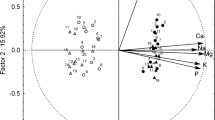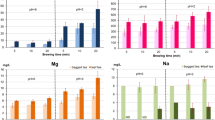Abstract
Essential elemental concentrations of Turkish black, green, and earl grey tea infusions were determined with and without added lemon. Daily percentage elemental intake values from these 3 teas with and without lemon addition were calculated based on Recommended Dietary Allowances (RDA). Calcium (Ca), cobalt (Co), copper (Cu), iron (Fe), potassium (K), magnesium (Mg), sodium (Na), selenium (Se), and zinc (Zn) concentrations were increased after lemon addition. The chromium (Cr) concentration was decreased in green and earl grey teas and increased in black tea after lemon addition. The manganese (Mn) concentration was increased in green tea and decreased in black and earl grey teas after lemon addition. The phosphorus (P) concentration was increased in earl grey and green teas, and decreased in black tea after lemon addition. The daily intake value of Mn was found above the RDA value.
Similar content being viewed by others
Refrerences
Karak T, Bhagat RM. Trace elements in tea leaves, made tea and tea infusion: A review. Food Res. Int. 43: 2234–2252 (2010)
Gardner EJ, Ruxton CHS, Leeds AR. Black tea-helpful or harmful? A review of the evidence. Eur. J. Clin. Microbiol. 61: 3–18 (2007)
Gomes CSF, Silva JBP. Minerals and clay minerals in medical geology. Appl. Clay Sci. 36:4–21 (2006)
Karadogan T. Ozer H. Patatesin besin değeri ve insan beslenmesi yönünden önemi. J. Fac. Agric. 28: 306–317 (1997)
Arslan N, Togrul H. Türk çayında kalite parametreleri ve mineral maddelerin farklı demleme koşullarında deme geçme miktarları. J. Food 20: 179–185 (1995)
Committee to Review Dietary Reference Intakes for Vitamin D and Calcium, Food and Nutrition Board, Institute of Medicine. Dietary Reference Intakes for Calcium and Vitamin D. National Academy Press, Washington, DC, USA. p. 1 (2010)
Institute of Medicine. Dietary Reference Intakes for Calcium, Phosphorus, Magnesium, Vitamin D, and Fluoride. National Academy Press, Washington, DC, USA. pp. 71–313 (1997)
Brinch-Pedersen H, Borg S, Tauris B, Holm PB. Molecular genetic approaches to increasing mineral availability and vitamin content of cereals. J. Cereal Sci. 46: 308–326 (2007)
Institute of Medicine. Food and Nutrition Board. Dietary Reference Intakes for Vitamin A, Vitamin K, Arsenic, Boron, Chromium, Copper, Iodine, Iron, Manganese, Molybdenum, Nickel, Silicon, Vanadium, and Zinc. National Academy Press, Washington, DC, USA. pp. 197–773 (2001)
Mehra A, Lynch P, Saikat S, Chan L. Trace elements in tea (Camellia sinensis) and their bioavailability. p. 257. In: Tea in Health and Disease Prevention. Victor Preedy (ed). Academic Press, London, UK (2012)
Mehra A, Baker CL. Leaching and bioavailability of aluminum, copper and manganese from tea (Camellia sinensis) Food Chem. 100: 1456–1463 (2007)
Sofuoglu SC, Kavcar P. An exposure and risk assessment for fluoride and trace metals in black tea. J. Hazard. Mater. 158: 392–400 (2008)
Institute of Medicine. Food and Nutrition Board. Dietary Reference Intakes: Vitamin C, Vitamin E, Selenium, and Carotenoids. National Academy Press, Washington, DC, USA. pp. 284–324 (2000)
Cichoke JA. The Complete Book of Enzyme Therapy. Penguin, NY, USA. p. 62 (1999)
Medeiros D. Wildman REC. Advanced Human Nutrition. 2nd ed. Jones & Bartlett Learning, LLC., London, UK. p. 389 (2011)
Prasad MNV. Trace Elements as Contaminants and Nutrients: Consequences in Ecosystems and Human Health. John Wiley & Son, NJ, USA. p. 30 (2008)
Passmore R. Handbook on Human Nutritional Requirements. Food & Agriculture Org, Rome, Italy. p. 65 (1974)
Reilly C. The Nutritional Trace Metals. John Wiley & Sons, Oxford, UK. p. 223 (2008)
The International Organization for Standardization (ISO) 103. Tea — Preparation of Liquor for Use in Sensory Tests. p. 4 (1980)
Zhang C. Fundamentals of Environmental Sampling and Analysis. John Wiley & Sons, NJ, USA. p. 221 (2007)
Gallaher N, Gallaher K, Marshall AJ, Marshall AC. Mineral analysis of ten types of commercially available tea. J. Food Compos. Anal. 19:53–57 (2006)
Food Standards Agency. Safe Upper Levels for Vitamins and Minerals. Expert Group on Vitamins and Minerals, Food Standards Agency, London, UK. p. 360 (2003)
U.S. Department of Agriculture and U.S. Department of Heath and Human Services. Dietary Guidelines for Americans. 7th ed. U.S. Government Printing Office, Washington, DC, USA. p. 95 (2010)
Institute of Medicine of the National Academies. Dietary Reference Intakes for Water, Potassium, Sodium, Chloride, and Sulfate. National Academy Press, Washington, DC, USA. p. 614 (2005)
University at Hawaii at Manoa. Nutrition ATC, a resource or sports & fitness professionals. Available from: http://www.nutritionatc. hawaii.edu/UL.htm. Accessed Apr. 9, 2013.
Reto M, Figueira MA, Almeida CMM. Chemical composition of green tea (Camellia sinensis) infusions commercialized in Portugal. Plant Food. Hum. Nutr. 62: 139–144 (2007)
Gorur FK, Keser R, Akcay N, Dizman S, Okumusoglu NT. Radionuclides and heavy metals concentrations in Turkish market tea. Food Control 22: 2065–2070 (2011)
Seenivasan S, Manikandan N, Muraleedharan NN. Chromium contamination in black tea and its transfer into tea brew. Food Chem. 106: 1066–1069 (2008)
Shen F, Chen H. Element composition of tea leaves and tea infusions and its impact on health. B. Environ. Contam. Tox. 80: 300–304 (2008)
Natesan S, Ranganathan V. Content of various elements in different parts of the tea plant and in infusions of black tea from southern India. J Food Sci. Agr. 51: 125–139 (1990)
Malik J, Szakova J, Drabek O, Balik J, Kokoska L. Determination of certain micro and macroelements in plant stimulants nd their infusions. Food Chem. 111: 520–525 (2008)
Author information
Authors and Affiliations
Corresponding author
Rights and permissions
About this article
Cite this article
Derun, E.M. Determination of essential mineral concentrations in some turkish teas and the effect of lemon addition. Food Sci Biotechnol 23, 671–675 (2014). https://doi.org/10.1007/s10068-014-0091-7
Received:
Revised:
Accepted:
Published:
Issue Date:
DOI: https://doi.org/10.1007/s10068-014-0091-7




